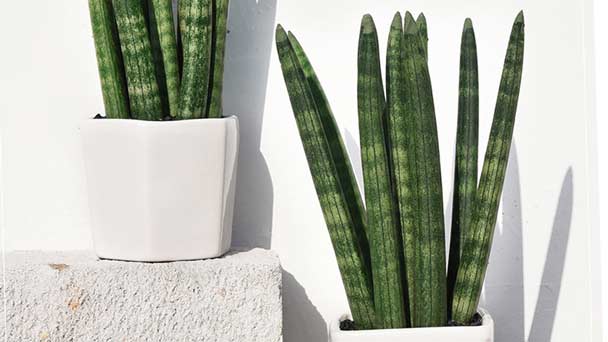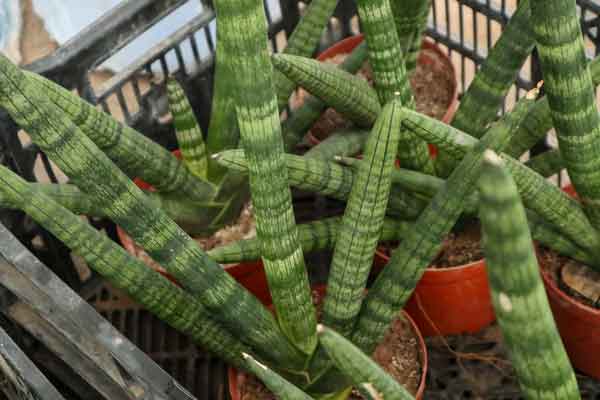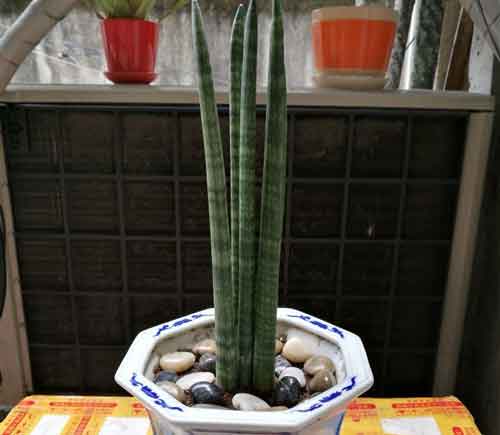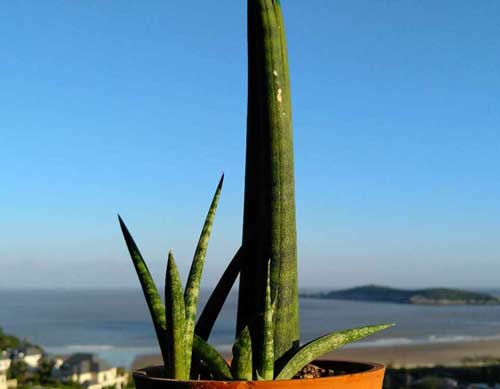Sansevieria Cylindrica (African Spear Plant) Grow & Care Guide
Written by Iris
Sep 23 2021

Sansevieria Cylindrica, also known as African Spear Plant, is a succulent plant made of upright grayish-green leaves shaped like a subtle stripe. The leaves of Sansevieria Cylindrica are cylindrical but narrow at the tip. When grown under optimal conditions, Sansevieria Cylindrica may emit long spikes from their centers, covered with tiny, delicate white flowers. Sansevieria Cylindrica (African Spear Plant) are best planted at the start of the spring growing season and are usually a slow growing succulent.
You also want to keep taps with these other handy propagation tips:
Use a sterilized pair of scissors to dissect a few healthy leaves from the mother Sansevieria Cylindrica plant.
The open wounds need to heal and form a callus that protects the newly propagated cuttings from catching diseases, so it's essential to place them out in the sun for a couple of days.
Place the base part of the cuttings in a jar full of water and wait for the baby roots to develop.
You can also propagate the Sansevieria Cylindrica cuttings using soil. Just remember to follow the tips right under the soil and transplanting section while preparing the potting mix.
If you're looking to propagate sansevieria cylindrica using water, transfer the cuttings in a growing medium once the pups begin to emerge.
Apart from vine weevils, be careful about overwatering plants so they won't experience root rot or other fungal infections.
Be careful while handling plant as the tip of the leaves can be very sharp and cut skin if not handled with caution.
An african spear sansevieria plant growing in pots 10″ inches and larger can also become very heavy to move around.
Sansevieria Cylindrica‘Golden Hanhii’: The Golden Hanhii is also popularly known as the Bird’s Nest. This variety is a petite succulent with light green stripes that run horizontally on the leaves which form a striking rosette pattern as they grow older.
Sansevieria Cylindrica ‘Cleopatra’: This cultivar is one of the best options for indoor spaces such as your office, room, or balcony. While it's hard to find this variety in the market, it's one kind of an unfussy houseplant that grows at a slow pace but forms a striking rosette pattern if grown under the right conditions.
Sansevieria Cylindrica‘Black Gold’: The leaves of this popular perennial have golden-yellow stripes on the edges and grow sleekly tall to make the plant look winsome in any indoor setting.
Sansevieria Cylindrica‘Futura Robusta’: This is a distinct type of mothers-in-law’s tongue with leaves that have sleek stripes with an irregular shape. It grows compactly inside a small container and makes a delightful indoor accent.
How to Grow Sansevieria Cylindrica (African Spear Plant)Sansevieria Cylindrica Propagation with CuttingsSansevieria Cylindrica Propagation with RhizomesHow to Care for Sansevieria Cylindrica (African Spear Plant)Sansevieria Cylindrica Light RequirementsSansevieria Cylindrica Soil Care Sansevieria Cylindrica Watering Sansevieria Cylindrica Temperature & Humidity CareSansevieria Cylindrica Fertilizer CareSansevieria Cylindrica Pruning CareSansevieria Cylindrica Pests & Diseases CareVarieties of Sansevieria Cylindrica (African Spear Plant)Sansevieria Cylindrica (African Spear Plant) FAQAre Sansevieria Cylindrica toxic to cats and dogs?Is Sansevieria Cylindrica difficult to maintain?
How to Grow Sansevieria Cylindrica (African Spear Plant)
Sansevieria Cylindrica Propagation with Cuttings
You just need a few easy tips on how to propagate Sansevieria Cylindrica. While Sansevieria Cylindrica prefers a growing medium that's not waterlogged, developing its rooting system using water is one of the most facile methods known for yielding the best results during the whole propagation phase. For a tenable yield, you can use leaf cuttings to propagate sansevieria Cylindrica. Don't use leaves that look too old or have signs of rotting. Before dissecting the Sansevieria Cylindrica leaves from the mother plant, make sure they're at least 6 inches long.You also want to keep taps with these other handy propagation tips:
Use a sterilized pair of scissors to dissect a few healthy leaves from the mother Sansevieria Cylindrica plant.
The open wounds need to heal and form a callus that protects the newly propagated cuttings from catching diseases, so it's essential to place them out in the sun for a couple of days.
Place the base part of the cuttings in a jar full of water and wait for the baby roots to develop.
You can also propagate the Sansevieria Cylindrica cuttings using soil. Just remember to follow the tips right under the soil and transplanting section while preparing the potting mix.
If you're looking to propagate sansevieria cylindrica using water, transfer the cuttings in a growing medium once the pups begin to emerge.
Sansevieria Cylindrica Propagation with Rhizomes
To propagate Sansevieria Cylindrica, understand they grow with rhizomes. Sansevieria Cylindrica send off runners or offshoot that can be untangled and separated with a sharp knife or blade if you want to propagate the plant. Wait until the stalks of the plant are at least 6 inches tall before you separate the plants and pot them individually.
How to Care for Sansevieria Cylindrica (African Spear Plant)
Sansevieria Cylindrica Light Requirements
Sansevieria Cylindrica (African Spear Plant) can tolerate somewhat low light conditions, but Sansevieria Cylindrica prefer some full sunlight along with bright filtered light. Outdoors Sansevieria Cylindrica will appreciate morning sun but should be protected from direct hot afternoon sun. Indoors they like a bright north-facing window. Too strong of light can cause the leaves to yellow around the edges, and too little light can result in subpar leaf growth.Sansevieria Cylindrica Soil Care
Like all succulents, Sansevieria Cylindrica has some special needs when it comes to planting. Drainage is crucial to keeping any succulent happy and this is no different for Sansevierias. Normal potting soil retains too much water and is not suitable unless mixed with sand and/or perlite to improve drainage. You can also buy a pre-mixed succulent soil that contains a mixture that works well for Sansevieria.Sansevieria Cylindrica Watering
Water thoroughly, then allow the potting mix to dry out before watering again. Don't water the center of the rosette because the leaves will easily rot. Water the soil, taking care not to get water on the Sansevieria Cylindrica leaves, which will cause them to rot. If the leaves turn yellow, or get soft and mushy at their base, the plant is overwatered.Sansevieria Cylindrica Temperature & Humidity Care
Sansevieria Cylindrica (African Spear Plant) is happy in places with temperatures between 15°C and 23°C and as low as 10°C for short periods. Sansevieria Cylindrica will do fine in normal household humidity. Avoid humid locations but if brown tips develop, consider occasional misting.Sansevieria Cylindrica Fertilizer Care
Feed Sansevieria Cylindrica once a month spring through fall with a fertilizer especially made for succulents, mixed at half the recommended strength. Over feeding Sansevieria Cylindrica can actually kill it as Sansevieria Cylindrica is a light feeder. You should not feed during winters when the growth is slow. If you like, you can also improve the soil with an organic granular fertilizer as well.Sansevieria Cylindrica Pruning Care
Sansevieria Cylindrica generally don't require pruning unless you want to do it for cosmetic purposes. However, if you notice a leaf turning yellow you can cut it at the base using pruning shears. Sansevieria Cylindrica is a popular ornamental houseplant as it is easy to culture and take care of. That's why they're preferred by busy home gardeners as they don't trouble them as such. Here are a few things you need to know in this regard.Sansevieria Cylindrica Pests & Diseases Care
Sansevieria Cylindrica is susceptible to vine weevils that eat away at the edges of the leaves. This can cause the plant a lot of irreversible harm. Get rid of the adult weevil with a neem oil soil drench. However, if the weevils manage to damage the roots significantly, the plant will probably be beyond saving.Apart from vine weevils, be careful about overwatering plants so they won't experience root rot or other fungal infections.
Be careful while handling plant as the tip of the leaves can be very sharp and cut skin if not handled with caution.
An african spear sansevieria plant growing in pots 10″ inches and larger can also become very heavy to move around.

Varieties of Sansevieria Cylindrica (African Spear Plant)
Sansevieria Cylindrica ‘Twisted Sister’: The Twisted Sister has curly leaves that grow in a warped pattern and have a yellow lining on the edges. It's more like the dwarf type among most other varieties since the leaves only range between 12” to 15’ inches tall.Sansevieria Cylindrica‘Golden Hanhii’: The Golden Hanhii is also popularly known as the Bird’s Nest. This variety is a petite succulent with light green stripes that run horizontally on the leaves which form a striking rosette pattern as they grow older.
Sansevieria Cylindrica ‘Cleopatra’: This cultivar is one of the best options for indoor spaces such as your office, room, or balcony. While it's hard to find this variety in the market, it's one kind of an unfussy houseplant that grows at a slow pace but forms a striking rosette pattern if grown under the right conditions.
Sansevieria Cylindrica‘Black Gold’: The leaves of this popular perennial have golden-yellow stripes on the edges and grow sleekly tall to make the plant look winsome in any indoor setting.
Sansevieria Cylindrica‘Futura Robusta’: This is a distinct type of mothers-in-law’s tongue with leaves that have sleek stripes with an irregular shape. It grows compactly inside a small container and makes a delightful indoor accent.

Sansevieria Cylindrica (African Spear Plant) FAQ
Are Sansevieria Cylindrica toxic to cats and dogs?
The ASPCA lists Sansevieria Cylindrica as toxic to both cats and dogs. So be careful with this species.Is Sansevieria Cylindrica difficult to maintain?
Not at all. You could forget about Sansevieria Cylindrica for a couple of months, and when you go see her, you will realize she is still thriving. Remarkably, they can do this, because it shows us how much strength they have. The more you forget about your sansevieria plant, the more (and the healthier) they will grow.Latest Updated
- Benefits of Bugleweed - 7 Science-backed Health Benefits
- Bugleweed Dangers & Side Effects - Is It Poisonous?
- How to Plant Evergreen Trees - What You Should Know
- When to Plant Evergreens - Grow Guide for Evergreen Trees
- 12 Wonderful Evergreen Shrubs for Your Garden
- 12 Popular Evergreen Plants with Pictures for Beginners
- When And How To Prune A Lilac Bush Like a Pro
- How to Grow & Care for Lilac Vine (Hardenbergia Violacea)
- Japanese Lilac Tree (Syringa Reticulata) Care & Propagation Guide
- Shumard Oak Pros and Cons - What to Know
Popular Articles
- Winter maintenance of Antirrhinum Majus
- How to Grow Terminalia Mantaly Tree
- How to Grow and Care for Crossostephium Chinense
- How to grow Antirrhinum Majus in spring
- Peristeria Elata (Dove Orchid) Profile: Info & Care Guide
- Underwatered Snake Plant (Sansevieria Trifasciata) - Signs And How To Fix
- How to Care for Brazilian Jasmine Plant (Mandevilla Sanderi)
- How to Grow & Care for Graptopetalum Purple Delight in Summer
- Rosa Chinensis (China Rose): Plant Growing & Care Tips
- How to Care for Baby Sun Rose (Aptenia Cordifolia)